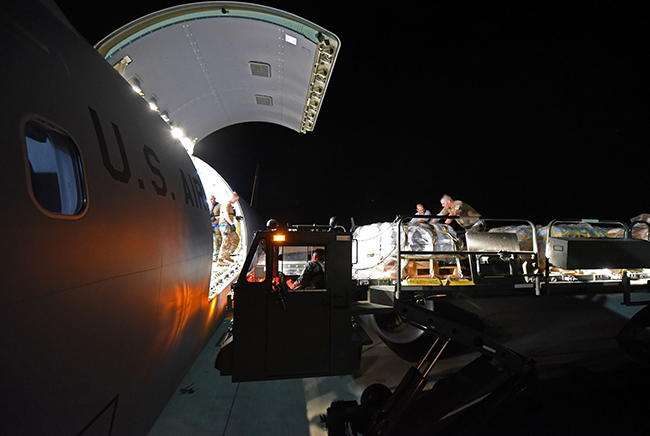
Airmen from the 60th Aerial Port Squadron from Travis AFB, Calif., load cargo onto a McConnell AFB, Kansas, KC-46A Pegasus on Aug. 21, 2019. Air Force photo by SrA. Christian Conrad.
The first major test phase for the Air Force’s next-generation tanker will likely last years, holding the KC-46 back from its initial operational capability milestone until after the aircraft’s biggest problem—the remote vision system—is fixed.
As the aircraft enters initial operational test and evaluation, KC-46 builder Boeing is finalizing a solution to a problem that has kept the KC-46 from carrying passengers and cargo. The company aims to have the fix in place within weeks.
Air Mobility Command boss Gen. Maryanne Miller told Air Force Magazine that moving the KC-46 into IOT&E is a positive step, that the tanker will “not come out of IOT&E until RVS is fixed.” Issues with the integral series of cameras and sensors that a boom operator uses to refuel aircraft have posed a complex problem for the Air Force and Boeing.
The service has outlined nine critical parameters the company must meet, and two have proven difficult. First is an issue with the display’s acuity, or definition—currently akin to 20/50 vision. There’s also a problem with depth perception, making it hard for an operator to know how far the boom is from the receiving aircraft. Meeting the parameters is seen as a pass/fail matter, and the Air Force recently said it remains “concerned about the slow progress” toward resolving those problems.
Miller said last month RVS shortfalls mean the KC-46 won’t be able to deploy for three to four years. RVS may also force the tanker to remain in IOT&E for years.
The Air Force and Boeing are also still working to address the most recent “category one” deficiencies, an issue with the locks that hold cargo and seats in the plane’s cargo bay. During pre-IOT&E flights, the locks signaled that they were not fully closed, Boeing said. Nothing came loose during the flights, but KC-46s are still not allowed to fly with cargo or passengers in the cargo bay.
Boeing said Oct. 28 that it successfully tested a new, retrofitted cargo lock that stops it from starting to disengage.
“The retrofit has already flown on the tanker during testing and meets all requirements,” the company said. “Boeing and the Air Force are planning to install the new locks on all KC-46 aircraft in the coming weeks. The safety of the KC-46 aircraft and crew is our top priority.”
AMC and Boeing are meeting again to discuss all the issues within weeks. Both the service and the company have laid out the milestones ahead, and Boeing set up labs to test system fixes, Miller said.
The IOT&E process is expected to raise more issues as testers vet the aircraft. Miller has met with the crews flying tanker test missions and working through the objectives. They must “not shortcut anything in this,” she said.
“We’ll add to the list of things to get after—that’s what IOT&E is really all about,” Miller said. “It really is wringing the airplane out.”
